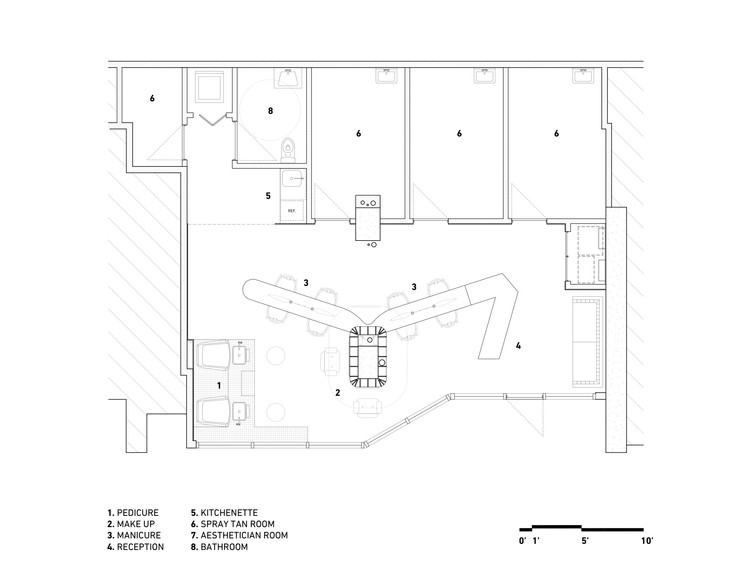AD Classics The Kyoto International Conference Center Sachio Otani
2013-07-18 01:00
Read more after the break...
1963年,日本首次举办了“会议中心必须作为京都的新标志”的全国建筑竞赛。在提交的195份参赛作品中,评审团委托了大田真纪夫(Sachio Otani)。他曾在广岛和平纪念馆(广岛和平纪念馆)的建三堂(Kenzo Tange)工作室工作,并于1960年开始自己的工作。
In 1963 Japan’s first national architecture competition was held for “A conference center that must function as a new symbol of Kyoto." Out of the 195 entries that were submitted, the jury commissioned Sachio Otani, who had previously worked in Kenzo Tange’s studio on the Hiroshima Peace Memorial Museum (1955) and started his own practice in 1960.
受该项目位于塔克拉戈代克湖畔的工地的启发,奥塔尼寻求将该建筑的野蛮外观与其绿色环境相结合的方法。他设计了一个广阔的日本花园,沿着湖边有混凝土小径,为游客提供了一个空间,让他们能够将刚硬的混凝土结构与自然融为一体。
Inspired by the project’s site on the shore of Lake Takaragaike, Otani sought a way to integrate the building’s brutalistic appearance into its green surroundings. He achieved this by designing an extensive Japanese garden with concrete pathways along the lake, providing visitors with a space that mediated the rigid concrete megastructucre and nature.
Photo by satti07 via flickr.com/photos/satti07. Used under Creative Commons
图片由sati 07通过flickr.com/相册/satti 07。在知识共享项下使用
由于这座建筑将成为来自世界各地游客的日本象征,奥塔尼认为,这座建筑应该“既反映日本传统的形式,又反映现代建筑思想的复杂和实用性。”[1]因此,从视觉和概念上相互补充的一系列重叠三角形衍生出156,000平方米建筑的形状,实际上是对传统形式的现代解读;三角形底座受周围山脉形状的启发,顶部是另一个反三角形,模仿日本传统塔的形状。
Because the building was to serve as a symbol of Japan for visitors from all over the world, Otani felt that the building should “reflect both traditional Japanese forms as well as the sophistication and practicality of modern architectural thinking." [1] Thus, the shape of the 156,000 square-meter structure, derived from a series of overlapping triangles that complement each other both visually and conceptually, is in fact a modern interpretation of traditional forms; the triangular base, inspired by the shape of the surrounding mountains, is topped by another, inverted triangle that mimics the shape of a traditional Japanese Pagoda.
这座建筑最巧妙的特色之一是钢筋混凝土柱,它以68度的角度倾斜,在不减少楼面面积的情况下戏剧性地影响了室内空间。另一个值得注意的是主会议厅,由一个独特的圆盘形状的反射器照明.该空间跨越四层,可容纳2000多人。建筑物的百分之七十由大厅和休息区组成,这些区域被窗户照亮,这些窗户提供了令人叹为观止的建筑物周围景色。
One of the building’s most ingenious features is its reinforced concrete columns; inclined at a sixty-eight degree angle, they dramatically impact the interior space without reducing floor area. Also of note is the main conference hall, lit by a unique disc-shaped reflector. The space spans over four floors and can hold over 2000 people. Seventy percent of the building is comprised of lobbies and lounging areas that are illuminated by windows that provide breathtaking views of the building’s surroundings.
The main conference hall, via www.congre.co.jp
主要会议厅,网址:www.congre.co.jp
今天,该中心仍然为其最初的目的提供便利,常年举办数十次会议。该中心于1997年被广泛关注,当时该中心设有“联合国气候变化框架公约”(COP 3),由此产生了著名的“京都议定书”。
Today the center still facilitates its original purpose, housing dozens of conferences year round. Much attention was drawn to the center in 1997, when it housed the UN Framework Convention on Climate Change (COP3) that resulted in the famous Kyoto Protocol.
[1]“建筑与社会”,1966年6月号,由日本建筑协会出版
[1] "Architecture and Society" June issue, 1966, published by the Japan Architecture Association
建筑师大田章雄位于日本京都1963年工程年占地面积165000.0平方米
Architects Sachio Otani Location Kyoto, Japan Area 165000.0 sqm Project Year 1963
 举报
举报
别默默的看了,快登录帮我评论一下吧!:)
注册
登录
更多评论
相关文章
-

描边风设计中,最容易犯的8种问题分析
2018年走过了四分之一,LOGO设计趋势也清晰了LOGO设计
-

描边风设计中,最容易犯的8种问题分析
2018年走过了四分之一,LOGO设计趋势也清晰了LOGO设计
-

描边风设计中,最容易犯的8种问题分析
2018年走过了四分之一,LOGO设计趋势也清晰了LOGO设计
























































